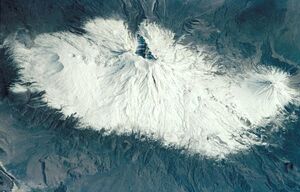m (clean up) |
(Adding categories) |
||
| (5 intermediate revisions by 3 users not shown) | |||
| Line 1: | Line 1: | ||
[[File:NEO ararat big.jpg|thumb|right|300px|Mount Ararat]] |
[[File:NEO ararat big.jpg|thumb|right|300px|Mount Ararat]] |
||
| + | '''Mount Ararat''' is likely the mountain in which the [[Ark of Noah]], landed with [[Noah]] and seven family members, after the recession of the waters from the [[Great Flood]].{{Reflist|colwidth=30em}}[[Category:Places]] |
||
| − | '''Mount Ararat''' (Turkish: ''Ağrı'', ''see below other:'' [[wikipedia:Mount Ararat#Names_and_etymology|names and etymology]]) is a snow-capped, dormant volcanic cone in Turkey. It has two peaks: '''Greater Ararat''' (the highest peak in Turkey, and the entire [[wikipedia:Armenian Highland|Armenian plateau]] with an [[wikipedia:summit (topography)|elevation]] of ) and '''Lesser Ararat''' (with an elevation of). |
||
| ⚫ | |||
| − | |||
| + | [[Category:NeedsVerses]] |
||
| − | The Ararat massif is about in diameter. The Iran-Turkey boundary skirts east of Lesser Ararat, the lower peak of the Ararat massif. It was in this area that, by the ''Tehran Convention of 1932'', a border change was made in Turkey's favour, allowing it to occupy the eastern flank of Lesser Ararat. |
||
| + | [[Category:Mountains]] |
||
| − | |||
| − | Mount Ararat in Judeo-Christian tradition is associated with the "Mountains of Ararat" where, according to the [[Book of Genesis]], [[Noah's Ark]] came to rest. |
||
| − | |||
| − | ==Names and Etymology== |
||
| − | *'''Ararat''' - The Bible says that Noah's ark landed on the mountains of Ararat. This does not refer to any specific mountain or peak, but rather a mountain range within the ''region'' of Ararat, which was the name of an ancient proto-Armenian kingdom also known as Urartu.<ref name="JVLib">{{cite web |title=Ararat |url=http://www.jewishvirtuallibrary.org/jsource/judaica/ejud_0002_0002_0_01234.html |year=2008 |work=Jewish Virtual Library |publisher= |accessdate=27 July 2009}}</ref> Nonetheless, one particular tradition identifies the mountain as Mount Masis, the highest peak in the Armenian Highland, which is therefore called Mount Ararat.<ref name="JVLib"/> (As opposed to the Armenian and European tradition, Semitic tradition identifies the mountain as Judi Dagh located in Turkey near Cizre.)<ref group=note>"Against the Armenian (and European) tradition that makes Masis the landing place of Noah, the Semitic tradition associated this landing with the mountain called Judi Dagh (earlier called Ararad or Sararad) located in Kurdistan northeast of Mosul.", Hewsen, p. 15{{ref|Hewsen 2001|Hewsen 2001}}</ref> According to the medieval Armenian historian Moses of Khoren in his ''[[wikipedia:History of Armenia (Movses Khorenatsi)|History of Armenia]]'', the plain of '''Ayrarat''' (directly north of the mountain) got its name after [[wikipedia:Ara the Beautiful|King Ara the Handsome]].<ref name="Thomson"/> Here the Assyrian [[wikipedia:Semiramis|Queen Semiramis]] is said to have lingered for a few days after the death of Ara.<ref name="Thomson"/> According to Thomson, the mountain is called Ararat ({{lang-hy|[[wikt:Արարատ|Արարատ]]}}) corresponding to Ayrarat, the name of the province.<ref group=note>"Masis: the Armenian name for the mountain south of the Araxes now called Ararat (by confusion with Ayrarat, the name of the province)". The ''Primary History'', Sebeos, p. 10, offers a different etymology, from the personal name 'Marseak'. Thomson, footnote on p. 91.{{ref|Thomson 1978|Thomson 1978}}</ref><ref group=note>Friedrich Murad, ''Ararat und Masis, Studien zur armenischen Altertumskunde und Litteratur'', Heidelberg, 1900. (Frederick Cornwallis Conybeare in a [http://www.jstor.org/stable/3152410?seq=2&Search=yes&term=Ararat&term=Eusebius&list=hide&searchUri=%2Faction%2FdoBasicSearch%3FQuery%3DEusebius%2BArarat%26wc%3Don%26dc%3DAll%2BDisciplines&item=1&ttl=35&returnArticleService=showArticle&resultsServiceName=doBasicResultsFromArticle 1901 review] states, "To anyone acquainted with Armenia, to speak of Ararat as a mountain is as if you spoke of Wales as such."</ref> |
||
| − | |||
| − | ==Notes== |
||
| − | {{Reflist|group=note}} |
||
| − | |||
| − | ==References== |
||
| − | {{Reflist|colwidth=30em}} |
||
| ⚫ | |||
Latest revision as of 21:55, 25 July 2020

Mount Ararat
Mount Ararat is likely the mountain in which the Ark of Noah, landed with Noah and seven family members, after the recession of the waters from the Great Flood.
